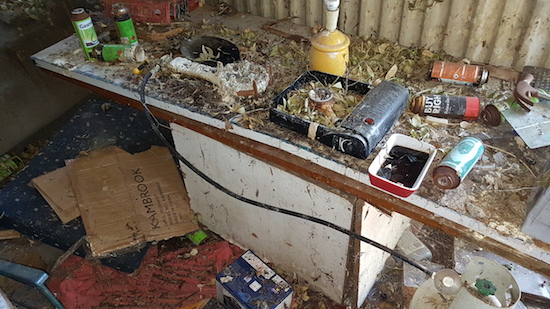Underground ice labs are springing up across Australia putting tenants, landlords and the general public at risk.
The manufacture of methamphetamine (meth or ‘ice’) produces a number of toxic chemicals which remain in the environment long after labs are shut down.
It’s crucial that everyone (particularly homeowners) understands how to spot a former meth lab, what dangerous chemicals could be present and why you should leave clean-up to the experts.
Spotting a Meth Lab
Unless police have gotten involved, it can be difficult to tell if a property has been used as a meth house.
Some warning signs for landlords include:
- Laboratory equipment including glass pyrex dishes, beakers and scales.
- An excess amount certain kitchen items such as paper towels, rubber gloves, coffee filters and hot plates.
- An excess of matchsticks (used for red phosphorous), drain cleaner, batteries (for Lithium) and prescription drugs such as cold and flu medications (for pseudoephedrine).
- Frequent visitors at all times of the day or night
- Unemployed, unfriendly or odd tenants.
- Blacked out windows.
- Excessive security including CCTV cameras and guard dogs.
- An odd chemical odour coming from the home or bins.
- Dead spots in grass indicating chemicals have been poured out.
- Excessive rubbish.
Most meth labs in Australia are found in residential houses where occupants are renting. It’s therefore important that landlords and potential renters are aware of the risks.
Meth labs commonly operate as “pop up” operations and may use a location for manufacturing only temporary before switching areas to avoid detection. Because of this, any suspicion that an area has been used to manufacture methamphetamine should be taken seriously.
Toxic Chemicals
Methamphetamine (‘ice’) is manufactured by transforming ephedrine, pseudoephedrine or phenyl-2-propanoane using a variety of hazardous chemicals.
These toxic transformation substances include iodine, hypophosphorus acid, anhydrous ammonia, lithium, methylamine and red phosphorous, all of which can linger and contaminate the environment.
One very dangerous by-product of ice manufacture is hydrogen chloride gas which turns into hydrochloric acid when in contact with water vapor burning and irritating eyes, skin and lungs.
Many of these chemicals are also highly flammable, with up to 20% of ice labs in residences both in Australia and the US identified as a result of an explosion or fire.
The desired product, ice, is also a chemical with a notable risk of harm.
Ice speeds up messaged between the body and brain increasing energy, reducing appetite and increasing hear rate. At high doses, ice can cause serious effects including psychosis, paranoia, aggression, stroke, heart attack and death.
During the manufacture process various chemicals and drug products are present in the air as gases, depositing on surfaces within the home. Moreover, liquid waste dumped down drains, stored in various containers indoors or dumped outside (to soil or water) can seep into the environment.
These chemicals linger in the home and surrounding areas for some time posing risks to future occupants.
The Health Risk
There are serious health risks involved in being in a house that was used as a meth lab.
The most commonly cited effects of ice houses include:
- Skin, eye and respiratory irritation;
- Dizziness;
- Headache;
- Insomnia;
- Nausea and vomiting;
- Impacts on mental health including mood swings, depression and psychosis.
- Increased heart rate, high blood pressure and increased risk of stroke.
- Cancer;
- Decreased fertility.
Risks are particularly high for children who are more susceptible to the effects of chemicals than adults.Concerningly, health effects can linger in someone’s system long after they have left the home.One medical report about a family who lived in an ice house in regional Victoria found very high methamphetamine levels in the hair of children who had contact with contaminated surfaces whilst playing.
“All family members experienced adverse health effects while living in the home” noted the researchers.
“The most serious health effects were reported in the youngest child (a boy aged 7 years) and included development of asthma-like symptoms, trouble sleeping, and behaviour changes”.
Cleaning Up a Meth Lab
If you suspect your property may have been used to manufacture ice it is important that you don’t try to clean it yourself.
Not only are you putting your own health at risk but it’s unlikely that you have the material or the specialist knowledge to clean the property successfully.
Meth Lab Cleaners Australia offers a comprehensive service to assisting in the clean-up and remediation of a property or area affected by meth labs and ice houses.
We provide you with assessment, testing and decontamination as part of a comprehensive drug lab remediation process.


Leave A Comment